A Dynamic TDMA Scheduling Strategy for MANETs Based on Service Priority
Abstract
:1. Introduction
1.1. Background and Motivation
1.2. Related Work
1.3. Innovations and Contributions
- A novel service priority-based distributed broadcast (SP-DB) mechanism is proposed, which introduces the service priority factor to prioritize various sensing information and enhance the adaptability to dynamic service requirements.
- A time slot reservation mechanism based on the consideration of multi-hop cooperative characteristic in the end-to-end transmission of MANETs is presented to ensure the continuity of service information transmission.
- A binary tree model-based adaptive time slot allocation mechanism is adopted to handle the traffic load of different service priority information efficiently.
- The MD-CCH algorithm for frame structure optimization is proposed to improve slot use of the system and further reduce end-to-end delay.
2. The Service Priority Based Dynamic TDMA Scheduling Algorithm
2.1. The Service Priority Based Distributed Broadcast Mechanism
| Algorithm 1 The SP-DS Time Slot Allocation Algorithm of Node j |
|
2.2. The Time Slot Reservation Mechanism
- In the first stage of RS, each reservation node will calculate the number of slots S that can be continuously reserved in the current control frame according to the binary tree model-based adaptive slot allocation mechanism, which will be mentioned in Section 2.4. When the reserved slots do not reach S, a reservation node needs to continue to reserve in RS, so it will broadcast its own ID in the third stage of RS.
- A reservation node has constructed a transmission path from itself to the destination node through the routing module before it starts time slot reservation, so it knows its next hop node ID when it is reserving time slot. To ensure that the current service information can be continuously transmitted by the routing nodes on the transmission path (as shown in Figure 6) to reduce the unnecessary delay, the order of time slot reservations among different nodes needs to be kept consistent with the order of routing nodes on the transmission path. In this case, the reservation node will broadcast its next hop node ID in the third stage of RS on the condition that the number of slots it has reserved reaches S. The node that received its own ID in the third stage of RS must send a reservation request in the first stage of RS, provided that its received node IDs in the fourth and fifth stage of RS are not within its two-hop range or the received priority numbers are lower than its own. Otherwise, it will back off. This is to ensure as far as possible that the next hop node of reservation node can reserve the slot DS successfully so that it can continue to transmit the same service information.
2.3. The Mathematical Expectation of Reservation Rounds
2.4. The Binary Tree Model Based Adaptive Slot Allocation Mechanism
| Algorithm 2 The Binary Tree Model Based Adaptive Slot Allocation Mechanism |
|
3. The Distributed Vertex Coloring Based Frame Structure Optimization Algorithm
3.1. The Model of Graph Vertex Coloring
3.2. The Modified Distributed Color Constraint Heuristic Algorithm
- The coloring starts from the nodes with the highest value of within their two-hop range. If there are multiple nodes with the same within two-hop range, the node with more one-hop neighbors () will be chosen as the starting node.
- All the one-hop neighbors of the starting nodes are colored based on the descending order of their .
- The remaining nodes decide when to start coloring according to the DSA-CCH algorithm. That is to say, a node starts to color itself when the , as shown in Equation (21) [29], exceeds a threshold. The threshold is set through experimental simulation (in our experimental simulation, considering the balance of coloring order between breadth-first and depth-first, the threshold is set to be 0.28 for making the weight of coloring order towards a breadth-first [29]).
| Algorithm 3 The MD-CCH Distributed Vertex Coloring Algorithm of Node j |
Input:_set[]; _set[]; Colors_set[]. Output: Consumed colors (M) in Colors_set[].
|
4. Experiment and Performance Evaluation
4.1. Experiment Settings
4.2. Experiment Results and Performance
4.2.1. Performance Comparison of Different Service Priority Information
4.2.2. Number of Colors
4.2.3. Running Time and Number of Reservation Rounds
4.2.4. End-to-end Delay and Throughput
5. Conclusions
Author Contributions
Funding
Conflicts of Interest
References
- Nadeem, A.; Howarth, M.P. A survey of MANET intrusion detection & prevention approaches for network layer attacks. IEEE Commun. Surv. Tutor. 2013, 15, 2027–2045. [Google Scholar]
- Glass, S.; Mahgoub, I.; Rathod, M. Leveraging MANET-based cooperative cache discovery techniques in VANETs: A survey and analysis. IEEE Commun. Surv. Tutor. 2017, 19, 2640–2661. [Google Scholar] [CrossRef]
- Barik, P.K.; Shukla, A.; Datta, R.; Singhal, C. A resource sharing scheme for intercell D2D communication in cellular networks: A repeated game theoretic approach. IEEE Trans. Veh. Technol. 2020, 69, 7806–7820. [Google Scholar] [CrossRef]
- Ye, Q.; Zhuang, W.; Li, L.; Vigneron, P. Traffic-load-adaptive medium access control for fully connected mobile ad hoc networks. IEEE Trans. Veh. Technol. 2016, 65, 9358–9371. [Google Scholar] [CrossRef]
- Cho, J.; Swami, A.; Chen, I. A survey on trust management for mobile ad hoc networks. IEEE Commun. Surv. Tutor. 2011, 13, 562–583. [Google Scholar] [CrossRef]
- Luo, J.; Ye, D.; Xue, L.; Fan, M. A survey of multicast routing protocols for mobile ad-hoc networks. IEEE Commun. Surv. Tutor. 2009, 11, 78–91. [Google Scholar]
- Peng, M.; Liu, W.; Wang, T.; Zeng, Z. Relay selection joint consecutive packet routing scheme to improve performance for wake-up radio-enabled WSNs. Wirel. Commun. Mob. Comput. 2020, 2020, 1–32. [Google Scholar] [CrossRef]
- Ye, Q.; Zhuang, W. Token-based adaptive MAC for a two-hop Internet-of-Things ennabled MANET. IEEE Internet Things J. 2017, 4, 1739–1753. [Google Scholar] [CrossRef]
- Butun, I.; Morgera, S.D.; Sankar, R. A survey of intrusion detection systems in wireless sensor networks. IEEE Commun. Surv. Tutor. 2014, 16, 266–282. [Google Scholar] [CrossRef]
- Gupta, L.; Jain, R.; Vaszkun, G. Survey of important issues in UAV communication networks. IEEE Commun. Surv. Tutor. 2016, 18, 1123–1152. [Google Scholar] [CrossRef] [Green Version]
- Lee, J.S.; Yoo, Y.; Choi, H.S.; Kim, T.; Choi, J.K. Energy-efficient TDMA scheduling for UVS tactical MANET. IEEE Commun. Lett. 2019, 23, 2126–2129. [Google Scholar] [CrossRef]
- Kim, D.; Kim, J.; Ko, Y. BiPi-TMAC: A bidirectional-pipelined TDMA for reliability and QoS support in tactical unmanned vehicle systems. IEEE Access 2018, 6, 26469–26482. [Google Scholar] [CrossRef]
- Lwin, M.T.; Yim, J.; Ko, Y.-B. Blockchain-based lightweight trust management in mobile ad-hoc networks. Sensors 2020, 20, 698. [Google Scholar] [CrossRef] [PubMed] [Green Version]
- Zheng, C.; Huang, S.; Wei, J.; Dong, Q. MD-MAC: A distributed TDMA protocol based on desynchronization for multi-hop topologies. Sensors 2019, 19, 5102. [Google Scholar] [CrossRef] [Green Version]
- Natkaniec, M.; Kosek-Szott, K.; Szott, S.; Bianchi, G. A survey of medium access mechanisms for providing QoS in ad-hoc networks. IEEE Commun. Surv. Tutor. 2013, 15, 592–620. [Google Scholar] [CrossRef]
- Roh, B.; Han, M.; Hoh, M.; Kim, K.; Roh, B. Tactical MANET architecture for unmanned autonomous maneuver network. In Proceedings of the 2016 IEEE Military Communications Conference (MILCOM), Baltimore, MD, USA, 1–3 November 2016; pp. 829–834. [Google Scholar]
- Li, Y.; Zhang, X.; Zeng, J.; Wan, Y.; Ma, F. A distributed TDMA scheduling algorithm based on energy-topology factor in internet of things. IEEE Access 2017, 5, 10757–10768. [Google Scholar] [CrossRef]
- Li, Y.; Zhang, X.; Qiu, T.; Zeng, J.; Hu, P. A distributed TDMA scheduling algorithm based on exponential backoff rule and energy-topology factor in internet of things. IEEE Access 2017, 5, 20866–20879. [Google Scholar] [CrossRef]
- Lin, C.; Zadorozhny, V.; Krishnamurthy, P.; Park, H.; Lee, C. A distributed and scalable time slot allocation protocol for wireless sensor networks. IEEE Trans. Mob. Comput. 2011, 10, 505–518. [Google Scholar] [CrossRef]
- Long, J.; Dong, M.; Ota, K.; Liu, A. A green TDMA scheduling algorithm for prolonging lifetime in wireless sensor networks. IEEE Syst. J. 2017, 11, 868–877. [Google Scholar] [CrossRef] [Green Version]
- Suriyachai, P.; Roedig, U.; Scott, A. A survey of MAC protocols for mission-critical applications in wireless sensor networks. IEEE Commun. Surv. Tutor. 2012, 14, 240–264. [Google Scholar] [CrossRef]
- Alvi, A.N.; Bouk, S.H.; Ahmed, S.H.; Yaqub, M.A.; Sarkar, M.; Song, H. BEST-MAC: Bitmap-assisted efficient and scalable TDMA-based WSN MAC protocol for smart cities. IEEE Access 2016, 4, 312–322. [Google Scholar] [CrossRef]
- Diaz-Anadon, M.O.; Leung, K.K. TDMA scheduling for event-triggered data aggregation in irregular wireless sensor networks. Comput. Commun. 2011, 34, 2072–2081. [Google Scholar] [CrossRef]
- Gholami, E.; Rahmani, A.M.; Dehghan Takht Fooladi, M. Adaptive and distributed TDMA scheduling protocol for wireless sensor networks. Wireless Pers. Commun. 2015, 80, 947–969. [Google Scholar] [CrossRef]
- Zhu, C.; Corson, M.S. A five-phase reservation protocol (FPRP) for mobile ad hoc networks. Wirel. Netw. 2001, 7, 371–384. [Google Scholar] [CrossRef]
- Rhee, I.; Warrier, A.; Min, J.; Xu, L. DRAND: Distributed randomized TDMA scheduling for wireless ad hoc networks. IEEE Trans. Mob. Comput. 2009, 8, 1384–1396. [Google Scholar] [CrossRef]
- Sato, K.; Sakata, S. A distance-measurement-oriented distributed TDMA scheduling algorithm for sensor networks. In Proceedings of the 2011 International Conference on Distributed Computing in Sensor Systems and Workshops (DCOSS), Barcelona, Spain, 27–29 June 2011; pp. 1–3. [Google Scholar]
- Sgora, A.; Vergados, D.J.; Vergados, D.D. A survey of TDMA scheduling schemes in wireless multihop networks. ACM Comput. Surv. (CSUR) 2015, 47, 53. [Google Scholar] [CrossRef]
- Bryan, K.L.; Ren, T.; DiPippo, L.; Henry, T.; Fay-Wolfe, V. Towards Optimal TDMA Frame Size in Wireless Sensor Networks; Technical Report; University of Rhode Island: South Kingstown, Rhode Island, 2007. [Google Scholar]
- Yao, M.; Lin, C.; Zhang, P.; Tian, Y.; Xu, S. TDMA scheduling with maximum throughput and fair rate allocation in wireless sensor networks. In Proceedings of the 2013 IEEE International Conference on Communications (ICC), Budapest, Hungary, 9–13 June 2013; pp. 1576–1581. [Google Scholar]
- Chang, C.; Chang, C.; Chen, S.; Tu, S.; Ho, K. Optimisation-based time slot assignment and synchronisation for TDMA MAC in industrial wireless sensor network. IET Commun. 2019, 13, 2932–2940. [Google Scholar] [CrossRef]
- Huang, M.; Liu, A.; Xiong, N.N.; Wang, T.; Vasilakos, A.V. An effective service-oriented networking management architecture for 5G-enabled internet of things. Comput. Netw. 2020, 173, 107208. [Google Scholar] [CrossRef]
- Misra, S.; Sarkar, S. Priority-based time-slot allocation in wireless body area networks during medical emergency situations: An evolutionary game-theoretic perspective. IEEE J. Biomed. Health Inf. 2015, 19, 541–548. [Google Scholar] [CrossRef]
- Li, M.; Gu, Z.; Long, Y.; Shu, X.; Rong, Q.; Ma, Z.; Shao, X. W-GPCR routing method for vehicular ad hoc networks. Sensors 2020, 20, 3406. [Google Scholar] [CrossRef]
- Nasrallah, A.; Thyagaturu, A.S.; Alharbi, Z.; Wang, C.; Shao, X.; Reisslein, M.; ElBakoury, H. Ultra-low latency (ULL) networks: The IEEE TSN and IETF DetNet standards and related 5G ULL research. IEEE Commun. Surv. Tutor. 2019, 21, 88–145. [Google Scholar] [CrossRef] [Green Version]
- Soelistijanto, B.; Howarth, M.P. Transfer reliability and congestion control strategies in opportunistic networks: A survey. IEEE Commun. Surv. Tutor. 2014, 16, 538–555. [Google Scholar] [CrossRef] [Green Version]
- Surendran, S.; Prakash, S. An ACO look-ahead approach to QoS enabled fault-tolerant routing in MANETs. China Commun. 2015, 12, 93–110. [Google Scholar] [CrossRef]
- Akhtar, N.; Khan, M.A.; Ullah, A.; Javed, M.Y. Congestion avoidance for smart devices by caching information in MANETs and IoT. IEEE Access 2019, 7, 71459–71471. [Google Scholar] [CrossRef]
- Wehrle, K.; Gunes, M.; Gross, J. Modeling and Tools for Network Simulation; Springer: Berlin/Heidelberg, Germany, 2010; pp. 15–34. [Google Scholar]
- Calamoneri, T. The L(h, k)-labelling problem: A survey and annotated bibliography. Comput. J. 2006, 49, 585–608. [Google Scholar] [CrossRef] [Green Version]
- Alon, N.; Mohar, B. The chromatic number of graph powers. Comb. Probab. Comput. 2002, 11, 1–10. [Google Scholar] [CrossRef] [Green Version]
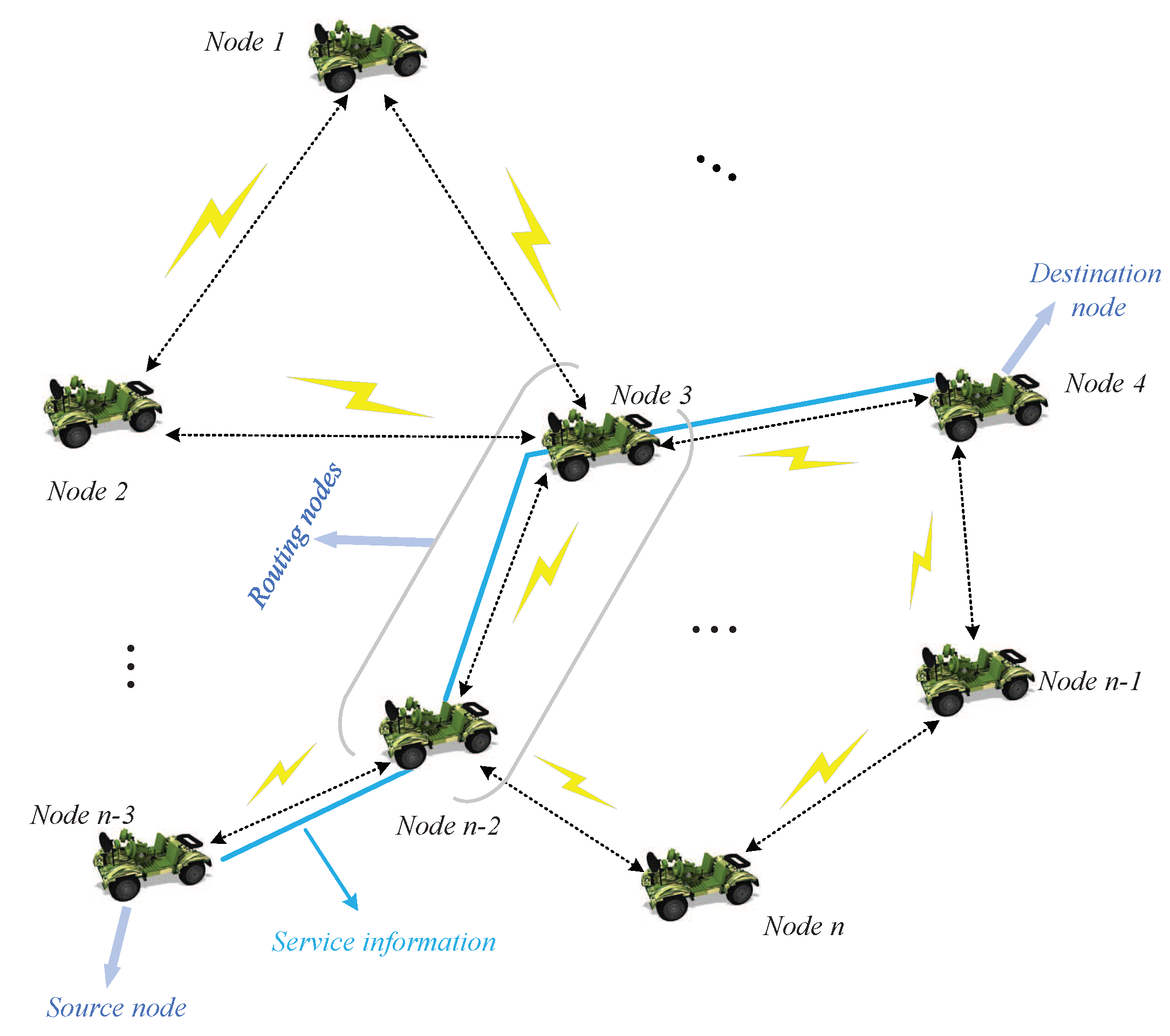



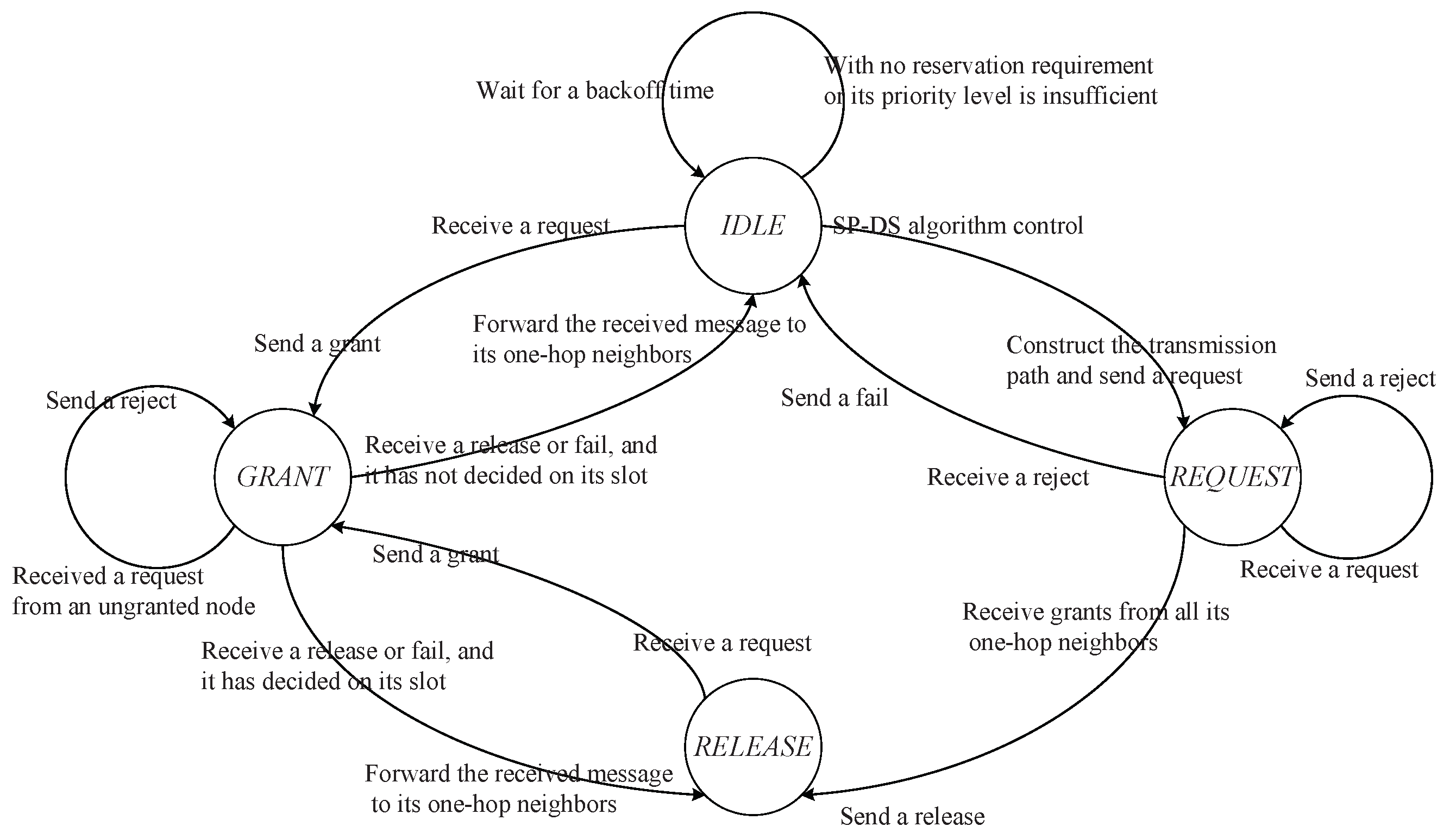
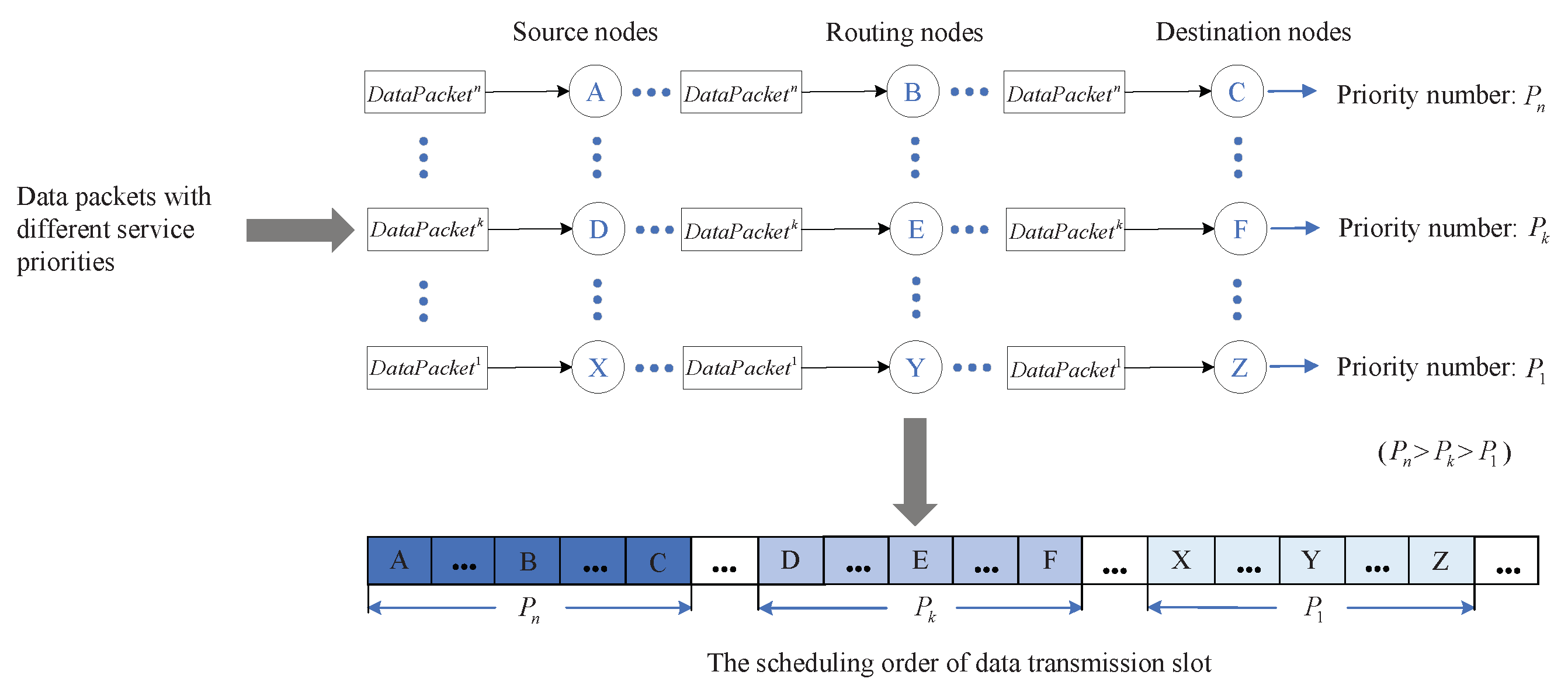
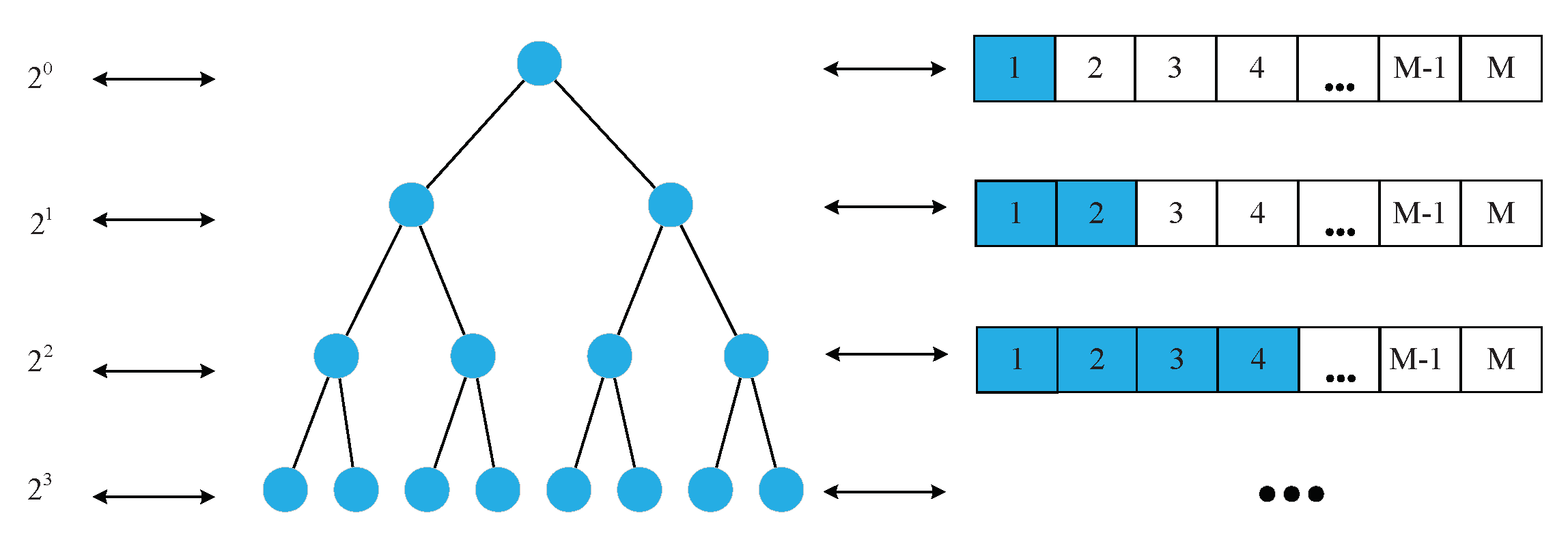


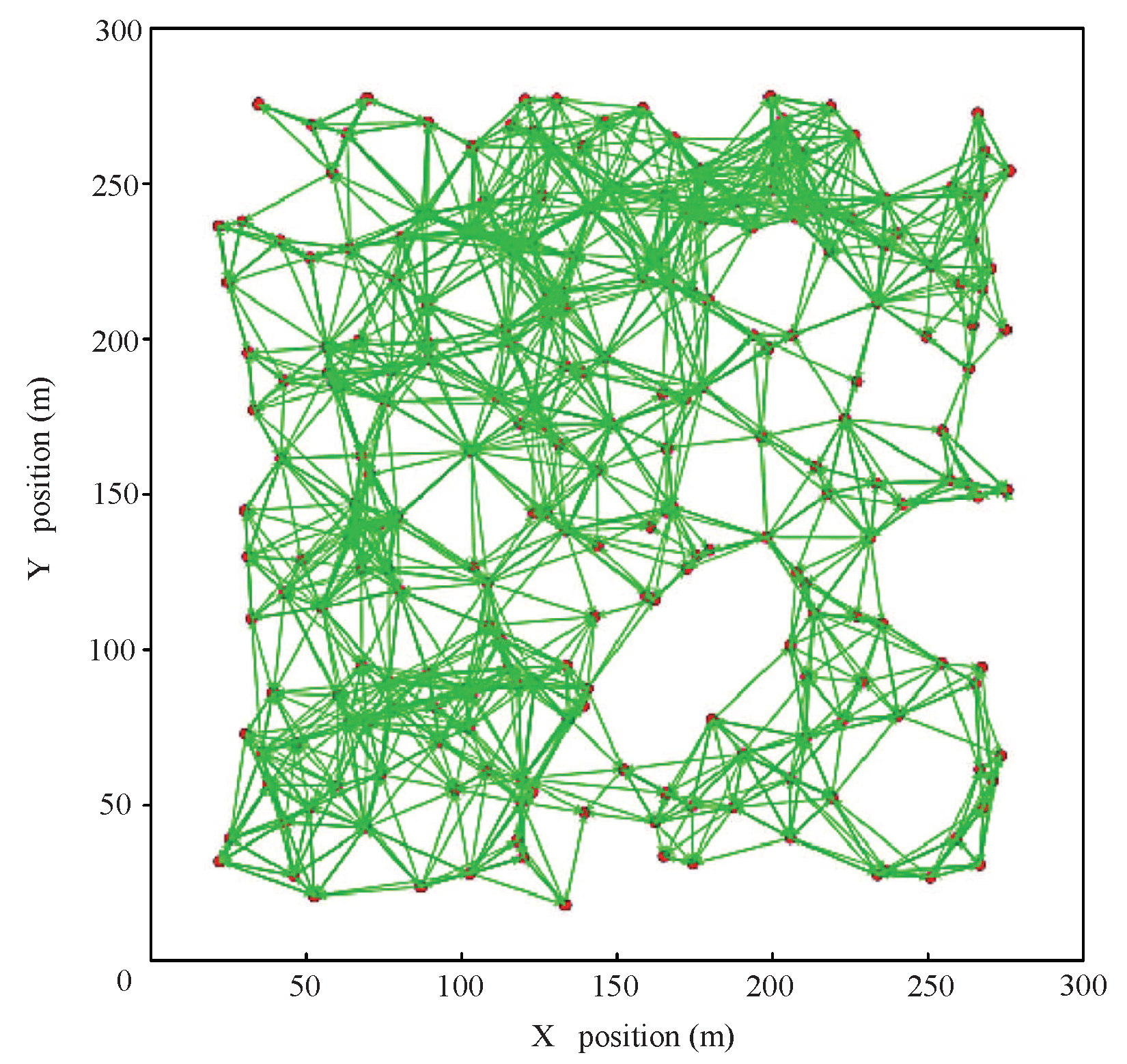
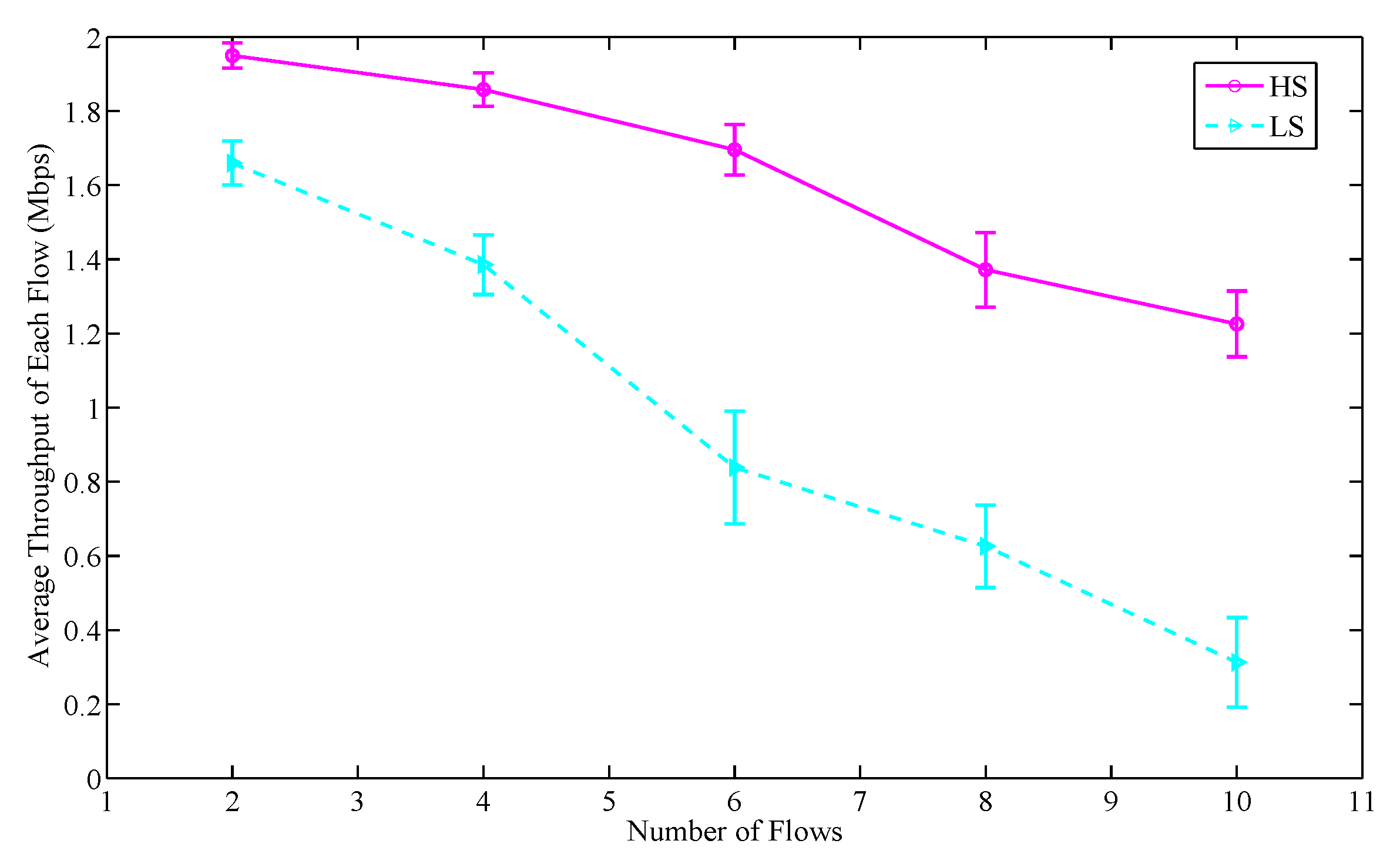
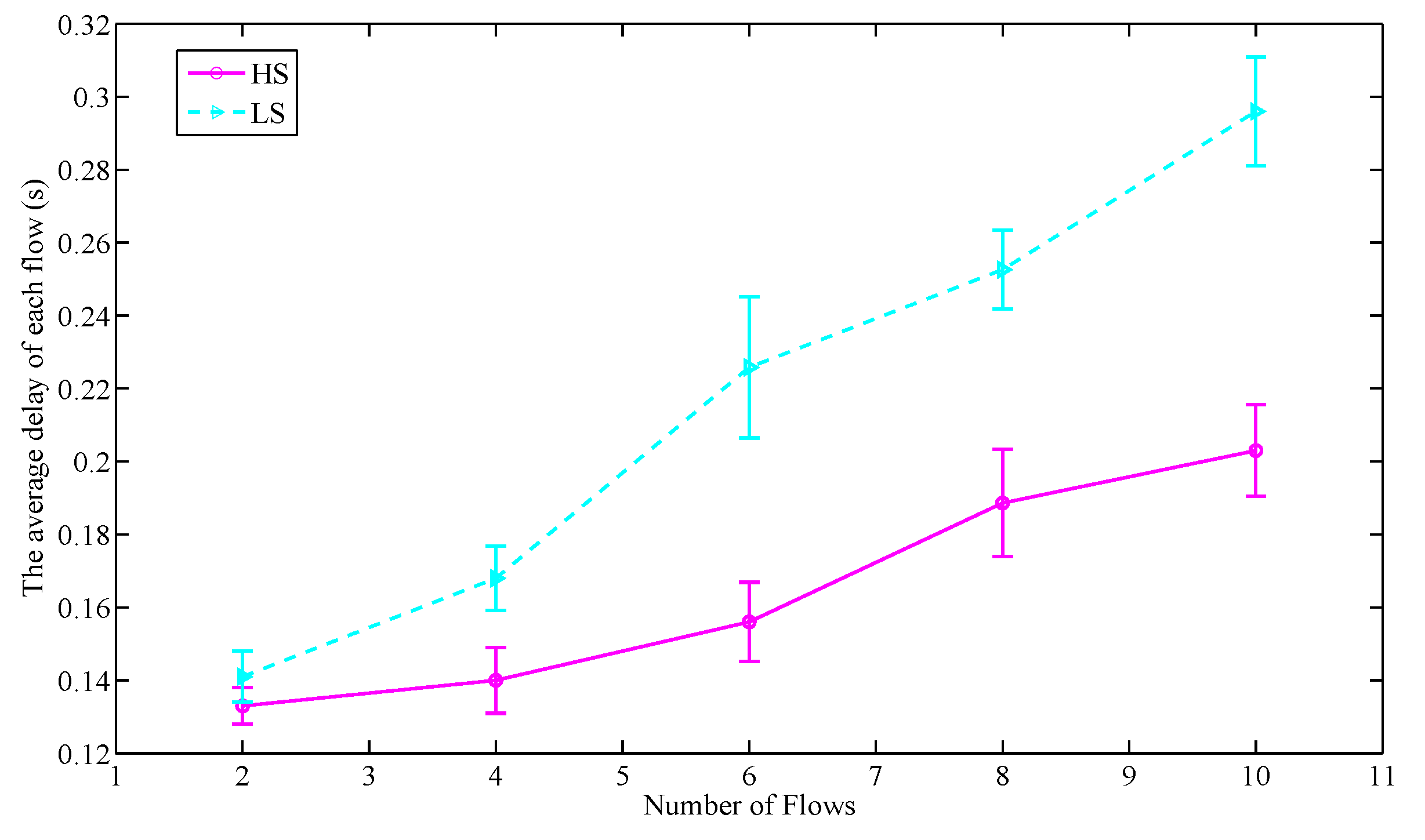
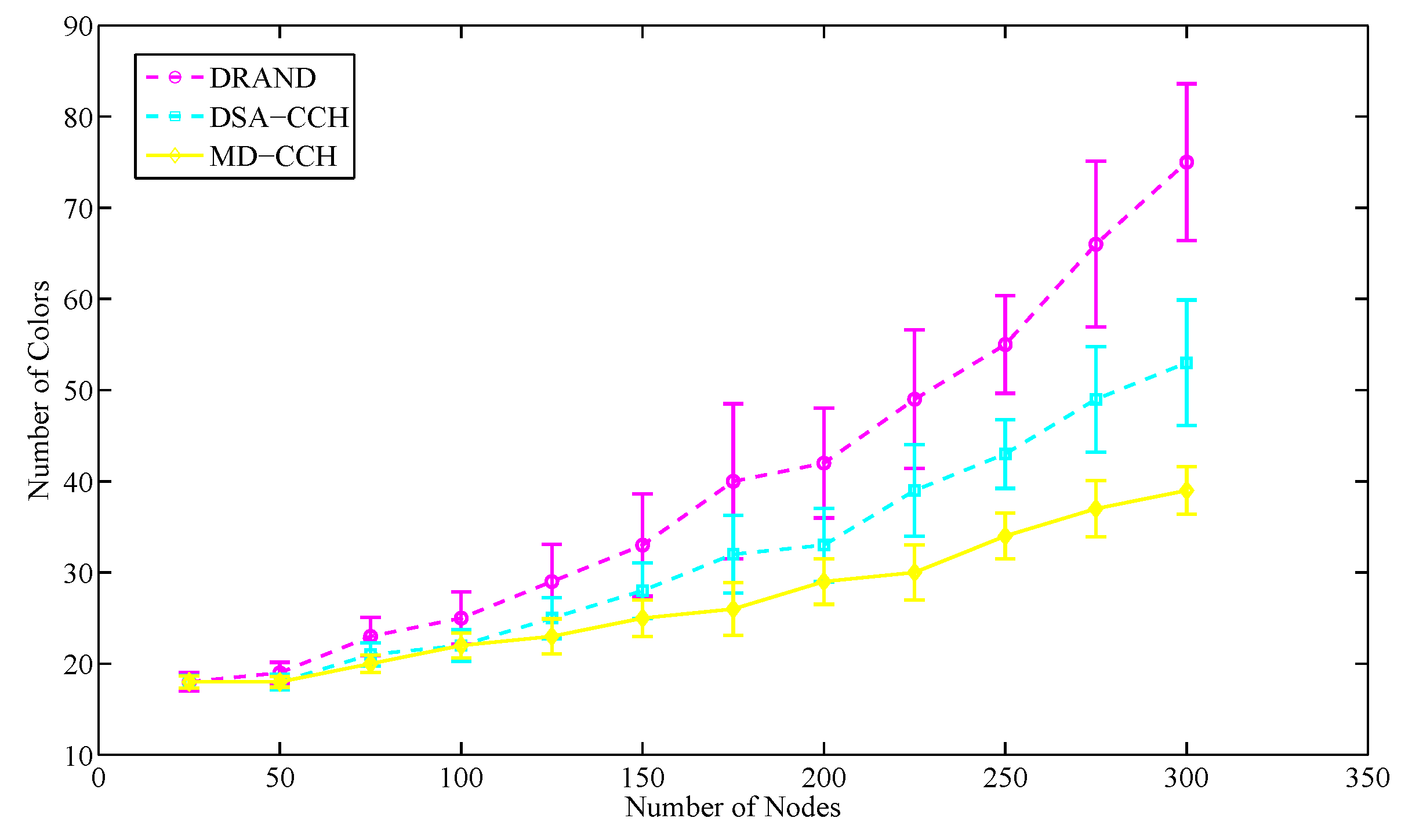
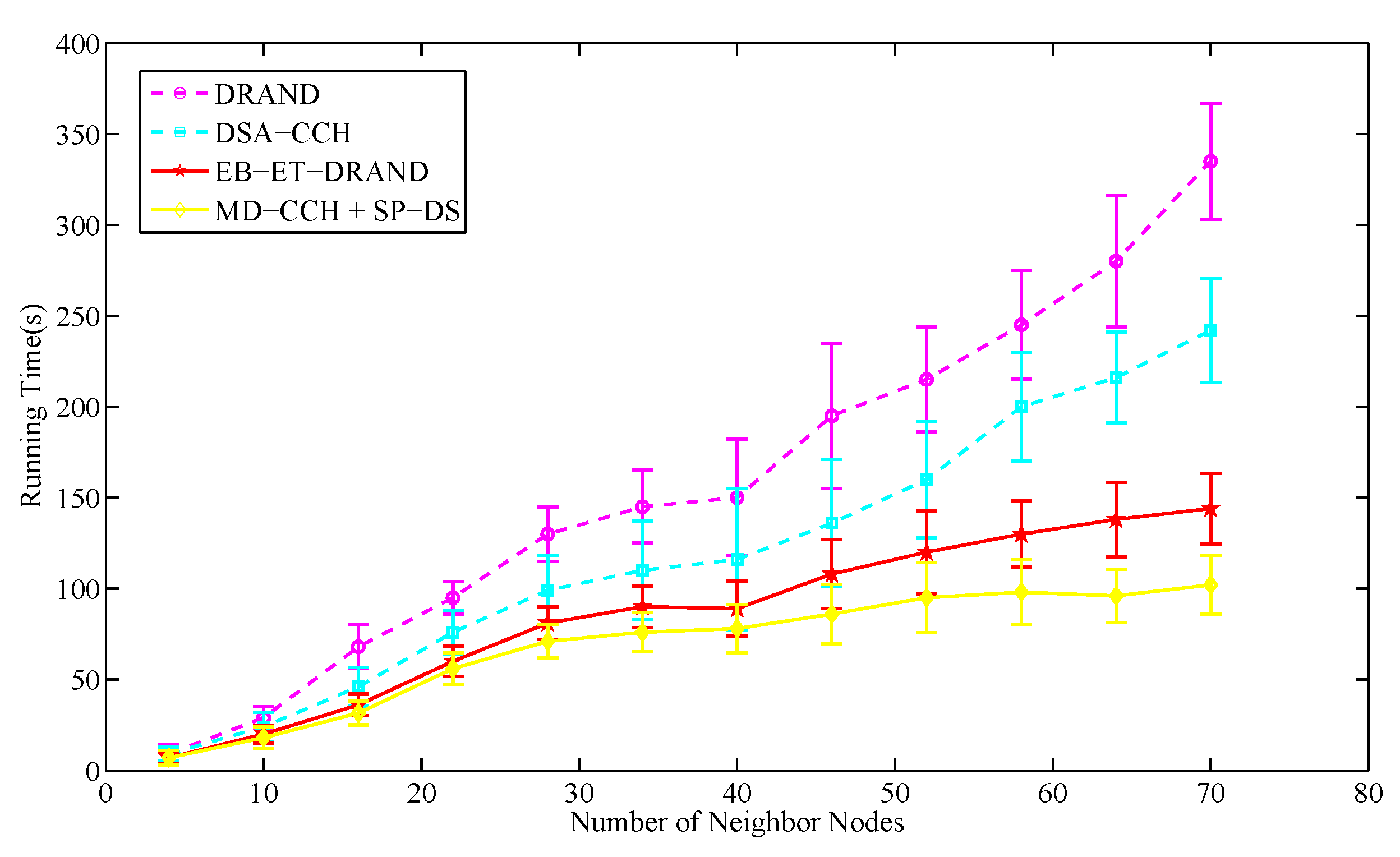
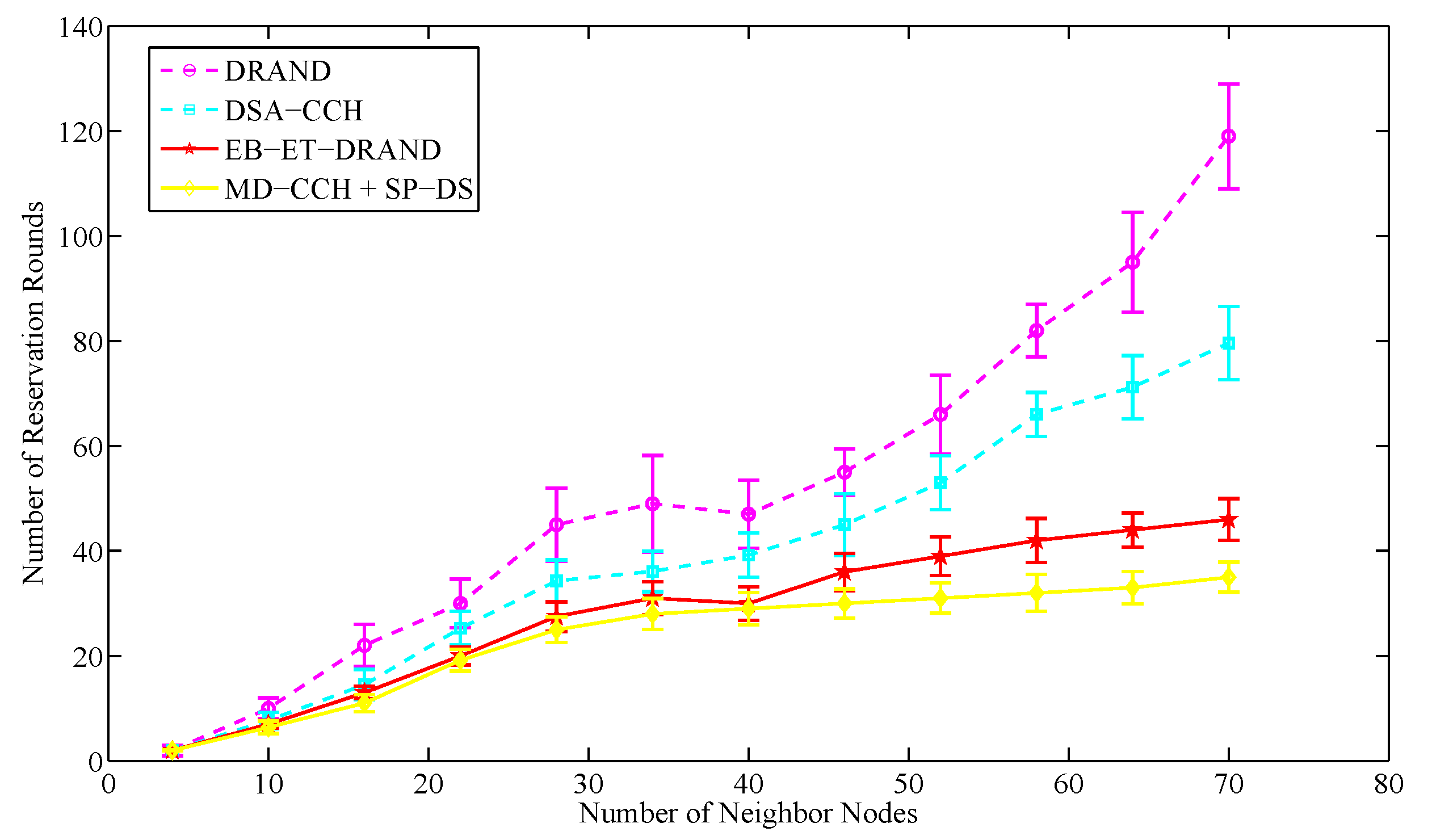

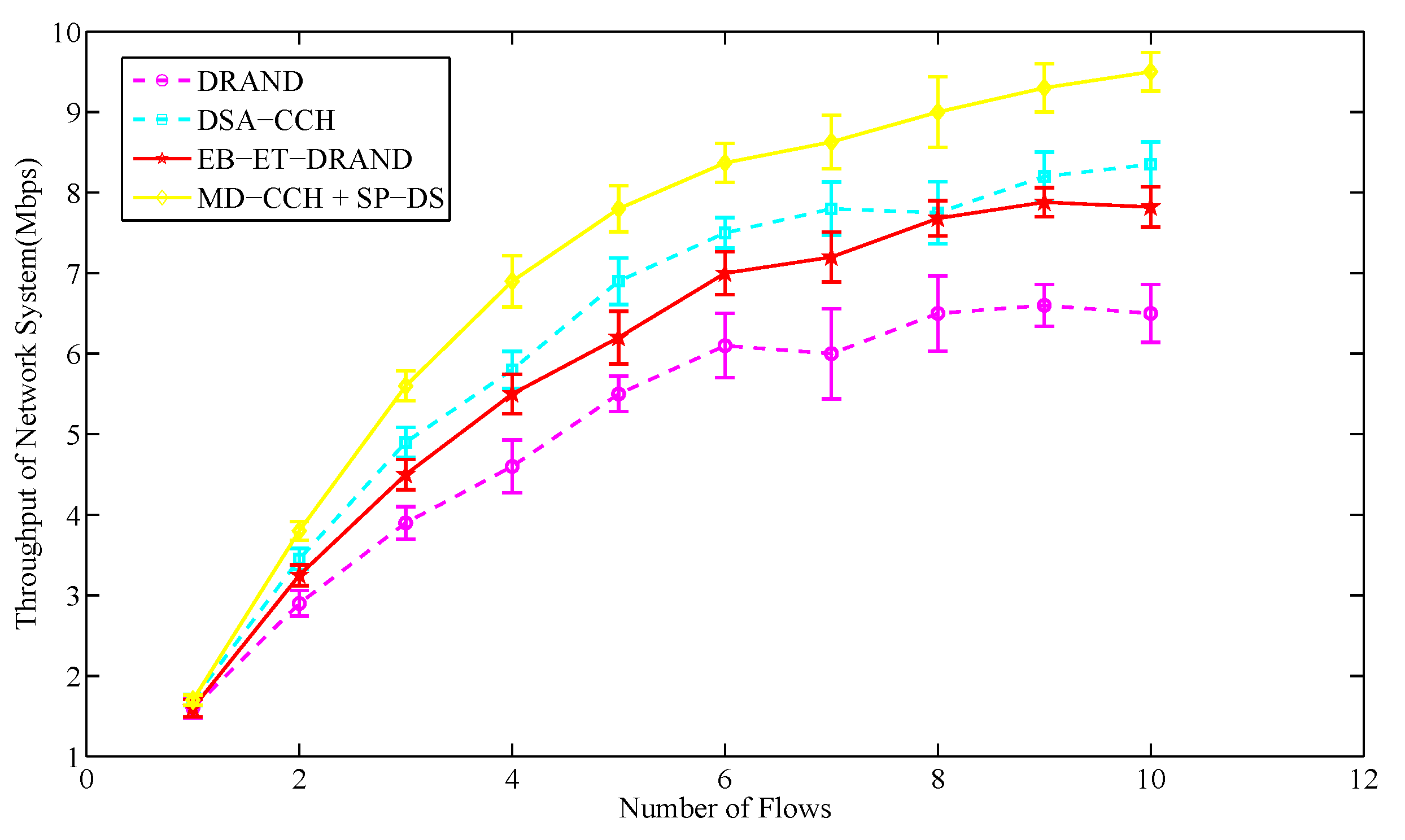
| Priority Number (N) | Service Type |
|---|---|
| 0 | A |
| 1 | B |
| 2 | C |
| 3 | D |
| 4 | E |
| ... | ... |
| NO. | Current State | Event | Action/Condition | Next State |
|---|---|---|---|---|
| 1 | IDLE | With the largest priority number within the two-hop range and the smallest token among the nodes of same level | Construct the transmission path and send a slot reservation request | REQUEST |
| 2 | IDLE | Receive a request from one of the one-hop neighbors | Send a grant | GRANT |
| 3 | IDLE | With no reservation requirement or its priority level is insufficient | Backoff | IDLE |
| 4 | REQUEST | The grant information from all one-hop neighbors is received | Send a release | RELEASE |
| 5 | REQUEST | Receive a request from another node | Send a reject | REQUEST |
| 6 | REQUEST | Receive a reject from one of the one-hop neighbors | Send a fail | IDLE |
| 7 | RELEASE | Receive a request from one of the one-hop neighbors | Send a grant | GRANT |
| 8 | GRANT | Receive a request from an ungranted node | Send a reject | GRANT |
| 9 | GRANT | Receive a release or fail, and it has not been allocated time slot | Forward the received message to its one-hop neighbors | IDLE |
| 10 | GRANT | Receive a release or fail, and it has been allocated time slot | Forward the received message to its one-hop neighbors | RELEASE |
| Parameter | Value |
|---|---|
| Topology model | ns3::Random Rectangle Position Allocator |
| Mobile model | ns3::Random Way Point Mobility Model |
| Propagation loss model | ns3::Log Distance Propagation Loss Model |
| Propagation delay model | ns3::Constant Speed Propagation Delay Model |
| Simulation area | 300 m × 300 m |
| Movement speed of nodes | 4 m/s |
| Number of nodes | [25,300] |
| Range of neighbour nodes | [4,70] |
| Link capacity | 2 Mbps |
| Broadcasting range(m) | 40 |
| Packet size | 256 Byte |
| Packet sending rate | 1000 packets/s |
| Routing protocol | AODV |
| Transfer protocol | UDP |
| Number of flows | 1–10 |
| Data flow generator | OnOffApplication |
Publisher’s Note: MDPI stays neutral with regard to jurisdictional claims in published maps and institutional affiliations. |
© 2020 by the authors. Licensee MDPI, Basel, Switzerland. This article is an open access article distributed under the terms and conditions of the Creative Commons Attribution (CC BY) license (http://creativecommons.org/licenses/by/4.0/).
Share and Cite
Ye, Y.; Zhang, X.; Xie, L.; Qin, K. A Dynamic TDMA Scheduling Strategy for MANETs Based on Service Priority. Sensors 2020, 20, 7218. https://doi.org/10.3390/s20247218
Ye Y, Zhang X, Xie L, Qin K. A Dynamic TDMA Scheduling Strategy for MANETs Based on Service Priority. Sensors. 2020; 20(24):7218. https://doi.org/10.3390/s20247218
Chicago/Turabian StyleYe, Yufeng, Xiangyin Zhang, Lanfeng Xie, and Kaiyu Qin. 2020. "A Dynamic TDMA Scheduling Strategy for MANETs Based on Service Priority" Sensors 20, no. 24: 7218. https://doi.org/10.3390/s20247218
APA StyleYe, Y., Zhang, X., Xie, L., & Qin, K. (2020). A Dynamic TDMA Scheduling Strategy for MANETs Based on Service Priority. Sensors, 20(24), 7218. https://doi.org/10.3390/s20247218







